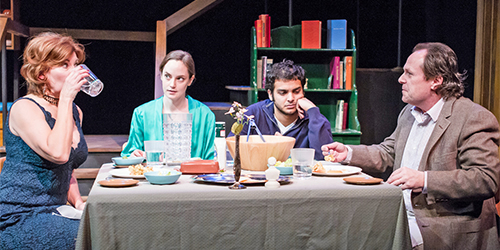By Carolyn Hayes

Following last season's "Brill," Performance Network Theatre and playwright David Wells have again teamed up to develop another world-premiere production, "County Line." In it, Wells spins a matter-of-fact story of a sweet 17-year-old girl who must enter foster care, and the woman she becomes. As directed by David Wolber, the production aims to strike harmony between the kind of emotional display that makes for a moving stage production and the script's florid narrative passages and devices that are reminiscent of young-adult fiction. The result is a powerful tale whose impact cannot be undone by its necessarily compromising concessions.
The play's events are told entirely through the perspective of protagonist Lois (Alissa Nordmoe), who in 2008 was enjoying an unassuming teenaged life in northwest Kansas with her devoted, albeit childish, single father (Phil Powers). Although Dad's comically tenuous grasp of responsibility has made Lois accustomed to faring for herself, the girl is nevertheless still a minor; thus, when her father is arrested, she finds herself living with Tanya (Julia Glander), in sight of the titular County Line truck stop where the foster mom works.
This expository legwork is accomplished in scenes heavily footnoted by long narration and asides, a tactic that gains traction when it becomes clear that the narrator is present-day Lois, six years later. Where the adult Lois is right now promises to be relevant, but what she intends to do - and what drove her to this point - is answered in the first act only with bitter foreboding.
As the second act sets out to answer the questions of the first, it unveils previously cloaked motivations, giving the secondary performers in particular ample room to grow.
The longest journey is that of Emilio Rodriguez as Darius, the other ward in Tanya's care; initially the human embodiment of a defense mechanism, Rodriguez incrementally opens his hardened self, making allusions to his wounds that become as telling as monologue while the teens build a unique closeness.
Glander keeps the viewer guessing as Tanya, skittering across a sliding scale of values that seems to differently trust and reward new versus indoctrinated, male versus female, and "good" versus "bad." The performer's seemingly arbitrary moods and retaliations are perfectly in tune with a character whose chief benefit of foster parenting is having a captive, compliant audience, and although her long con of feared toxicity takes its sweet time to pay off, it culminates in the play's most deeply affecting moment.
In addition to his charming deficiency as the hapless dad, Powers shows his range in a few additional roles, especially as he breathes life into a character expressly written to be wholeheartedly banal.
The design concept for the show's handful of settings and dueling past and present might be best described as literalism-to-a-point. Scenic designer Kirk Domer pulls together a thematic sense of place across a sprawl of concretely defined living spaces, which must serve double and triple duty as the story barrels between and through time and place.
The pattern of intricately specific choices whenever possible extends to the properties and costume design (by Charles Sutherland and Amber Marisa Cook, respectively): Each physically manifests every specifically discussed detail, but conveniently shrinks back when the narrative flow precludes a costume or set change.
Similarly, Mary Cole's lighting makes its presence deliberately felt at key moments, but just as often stays inexplicably out of the way. The inconsistencies ensure that nothing detracts from the production's consistently rolling pacing, but the sum total of crowded unambiguity and exceptions to same may not be the most seamless fit for what is largely a memory play.
Thematically, the show casts a melancholy pall over the classic coming-of-age story by dwelling on the notion of "the last time," in particular the unforeseen or uncontrollable kind. Cole and sound designer Ed Weingart exploit this by using engine sounds in concert with approaching headlights and receding taillights, letting the unseen County Line visitors reflect the wash of things that happen to Lois and often leave her in the figurative dust.
Here, though, the writing and direction shortchange the lead actress, too often giving her long internal monologues in lieu of engagement with the scene. Lois's dissociative responses to most developments increasingly take the form of symbolic prose on the order of Holden Caulfield; it's lovely and vivid, and handled deftly by skillful Nordmoe, but may be better suited to the page than to the emotional gut shot that live stage performance can provide. It's no coincidence that many of the finest payoffs come in beats that are free of interjection, where the young Lois and her scene partners are finally allowed to speak for themselves.
In all, "County Line" succeeds because of the weighty import of the script's subject matter, in spite of the less-immediate connection its heavily emblematic, arm's-length narration affords. The script undoubtedly holds thought-provoking resonance, with no shortage of brave storytelling - including, it should be noted, some coarse language and intimate sexual content.
Ultimately, this is a production set to make the viewer both think and feel, although for a play concerning a teenager in the throes of hardship, that scale is tipped in the opposite way from what one might expect.
REVIEW:
'County Line'
Performance Network Theatre, 120 E. Huron St., Ann Arbor. Thursday-Sunday through Feb. 16. 1 hour, 55 minutes. $22-41. 734-663-0681. http://www.performancenetwork.org









